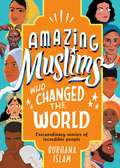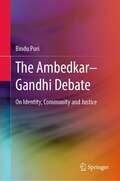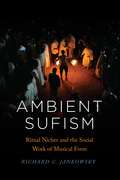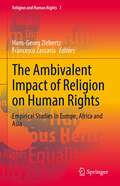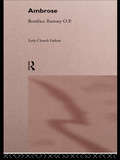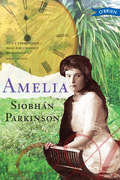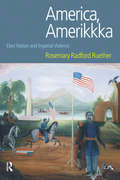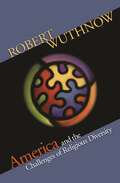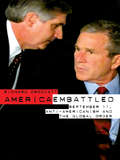- Table View
- List View
"The Amazing Iroquois" and the Invention of the Empire State
by John C. WintersIn America's collective unconscious, the Haudenosaunee, known to many as the Iroquois, are viewed as an indelible part of New York's modern and democratic culture. From the Iroquois confederacy serving as a model for the US Constitution, to the connections between the matrilineal Iroquois and the woman suffrage movement, to the living legacy of the famous "Sky Walkers," the steelworkers who built the Empire State Building and the George Washington Bridge, the Iroquois are viewed as an exceptional people who helped make the state's history unique and forward-looking. John C. Winters contends that this vision was not manufactured by Anglo-Americans but was created and spread by an influential, multi-generational Seneca-Iroquois family. From the American Revolution to the Cold War, Red Jacket, Ely S. Parker, Harriet Maxwell Converse (adopted), and Arthur C. Parker used the tools of a colonial culture to shape aspects of contemporary New York culture in their own peoples' image. The result was the creation of "The Amazing Iroquois," an historical memory that entangled indigenous self-definition, colonial expectations about racial stereotypes and Native American politics, and the personalities of the people who cultivated and popularized that memory. Through the imperial politics of the eighteenth century to pioneering museum exhibitions of the twentieth, these four Seneca celebrities packaged and delivered Iroquoian stories to the broader public in defiance of the contemporary racial stereotypes and settler colonial politics that sought to bury them. Owing to their skill, fame, and the timely intervention of Iroquois leadership, this remarkable family showcases the lasting effects of indigenous agents who fashioned a popular and long-lasting historical memory that made the Iroquois an obvious and foundational part of New Yorkers' conception of their own exceptional state history and self-identity.
Amazing Muslims Who Changed the World
by Burhana IslamDo you think you know who first thought of the theory of evolution? Have you ever wondered who created the oldest university in the world? Is Joan of Arc is the only rebel girl who led an army that you've heard of?Then you need this stunningly illustrated treasure trove of iconic and hidden amazing Muslim heroes.You'll find people you might know, like Malala Yousafzai, Mo Farah and Muhammad Ali, as well as some you might not, such as:Hasan Ibn Al-Haytham: the first scientist to prove theories about how light travels, hundreds of years before Isaac Newton.Sultan Razia: a fearsome female ruler.G. Willow Wilson: the comic book artist who created the first ever Muslim Marvel character.Ibtihaj Muhammad: the Olympic and World Champion fencer and the first American to compete in the games wearing a hijab.Noor Inayat Khan: the Indian Princess who became a British spy during WWII.There are so many more amazing Muslim men and women who have changed our world, from pirate queens to athletes, to warriors and mathematicians. Who will your next hero be?
Ambassadors of Christ: Commemorating 150 Years of Theological Education in Cuddesdon 1854–2004
by Mark D. ChapmanAmbassadors of Christ commemorates 150 years of theological education in Cuddesdon with a collection of substantial essays. It begins with a discussion by Mark Chapman of the revival of theology and education in the early years of the nineteenth century. This is followed by essays by Alastair Redfern on Samuel Wilberforce as a pastoral theologian and a revision by Andrew Atherstone of Owen Chadwick’s Centenary History in the light of more recent historical research, bringing the discussion up to the 1880s. For the first time, Ripon Hall, which merged with Cuddesdon in 1975, receives a thorough and detailed historical treatment by Michael Brierley. Mark Chapman then discusses the 1960s under Robert Runcie, and a final chapter by Robert Jeffery deals with the theological and churchmanship issues which emerged from the merger. Two marvellous sermons preached at College Festivals by Michael Ramsey and Owen Chadwick are also reproduced in appendices. This special commemorative volume will appeal to past and present students as well as specialists in nineteenth and twentieth-century church history and all those interested in ministerial education and spiritual formation. Â
Ambassadors of Christ: Commemorating 150 Years of Theological Education in Cuddesdon 1854–2004
by Mark D. ChapmanAmbassadors of Christ commemorates 150 years of theological education in Cuddesdon with a collection of substantial essays. It begins with a discussion by Mark Chapman of the revival of theology and education in the early years of the nineteenth century. This is followed by essays by Alastair Redfern on Samuel Wilberforce as a pastoral theologian and a revision by Andrew Atherstone of Owen Chadwick’s Centenary History in the light of more recent historical research, bringing the discussion up to the 1880s. For the first time, Ripon Hall, which merged with Cuddesdon in 1975, receives a thorough and detailed historical treatment by Michael Brierley. Mark Chapman then discusses the 1960s under Robert Runcie, and a final chapter by Robert Jeffery deals with the theological and churchmanship issues which emerged from the merger. Two marvellous sermons preached at College Festivals by Michael Ramsey and Owen Chadwick are also reproduced in appendices. This special commemorative volume will appeal to past and present students as well as specialists in nineteenth and twentieth-century church history and all those interested in ministerial education and spiritual formation. Â
The Ambedkar–Gandhi Debate: On Identity, Community and Justice
by Bindu PuriThis book reconstructs the philosophical issues informing the debate between the makers of modern India: Ambedkar and Gandhi. At one level, this debate was about a set of different but interconnected issues: caste and social hierarchies, untouchability, Hinduism, conversion, temple entry, and political separatism. The introduction to this book provides a brief overview of the engagements and conflicts in Gandhi and Ambedkar's central arguments. However, at another level, this book argues that the debate can be philosophically re-interpreted as raising their differences on the following issues: The nature of the self,The relationship between the individual self and the community,The appropriate relationship between the constitutive encumbrances of the self and a conception of justice,The relationship between memory, tradition, and self-identity. Ambedkar and Gandhi’s contrary conceptions of the self, history,itihaas, community and justice unpack incommensurable world views. These can be properly articulated only as very different answers to questions about the relationship between the present and the past. This book raises these questions and also establishes the link between the Ambedkar--Gandhi debate in the early 20th century and its re-interpretation as it resonates in the imagination and writing of marginalized social groups in the present times.
Ambient Sufism: Ritual Niches and the Social Work of Musical Form (Chicago Studies in Ethnomusicology)
by Richard C. JankowskyAmbient Sufism is a study of the intertwined musical lives of several ritual communities in Tunisia that invoke the healing powers of long-deceased Muslim saints through music-driven trance rituals. Richard C. Jankowsky illuminates the virtually undocumented role of women and minorities in shaping the ritual musical landscape of the region, with case studies on men’s and women’s Sufi orders, Jewish and black Tunisian healing musical troupes, and the popular music of hard-drinking laborers, as well as the cohorts involved in mass-mediated staged spectacles of ritual that continue to inject ritual sounds into the public sphere. He uses the term “ambient Sufism” to illuminate these adjacent ritual practices, each serving as a musical, social, and devotional-therapeutic niche while contributing to a larger, shared ecology of practices surrounding and invoking the figures of saints. And he argues that ritual musical form—that is, the large-scale structuring of ritual through musical organization—has agency; that is, form is revealing and constitutive of experience and encourages particular subjectivities. Ambient Sufism promises many useful ideas for ethnomusicology, anthropology, Islamic and religious studies, and North African studies.
Ambient Sufism: Ritual Niches and the Social Work of Musical Form (Chicago Studies in Ethnomusicology)
by Richard C. JankowskyAmbient Sufism is a study of the intertwined musical lives of several ritual communities in Tunisia that invoke the healing powers of long-deceased Muslim saints through music-driven trance rituals. Richard C. Jankowsky illuminates the virtually undocumented role of women and minorities in shaping the ritual musical landscape of the region, with case studies on men’s and women’s Sufi orders, Jewish and black Tunisian healing musical troupes, and the popular music of hard-drinking laborers, as well as the cohorts involved in mass-mediated staged spectacles of ritual that continue to inject ritual sounds into the public sphere. He uses the term “ambient Sufism” to illuminate these adjacent ritual practices, each serving as a musical, social, and devotional-therapeutic niche while contributing to a larger, shared ecology of practices surrounding and invoking the figures of saints. And he argues that ritual musical form—that is, the large-scale structuring of ritual through musical organization—has agency; that is, form is revealing and constitutive of experience and encourages particular subjectivities. Ambient Sufism promises many useful ideas for ethnomusicology, anthropology, Islamic and religious studies, and North African studies.
The Ambiguity of Play
by Brian Sutton-SmithFrom the Pilgrims who settled at Plymouth Rock to Christian Coalition canvassers working for George W. Bush, Americans have long sought to integrate faith with politics. Few have been as successful as Hollywood evangelist Aimee Semple McPherson. During the years between the two world wars, McPherson was the most flamboyant and controversial minister in the United States. She built an enormously successful and innovative megachurch, established a mass media empire, and produced spellbinding theatrical sermons that rivaled Tinseltown's spectacular shows. As McPherson's power grew, she moved beyond religion into the realm of politics, launching a national crusade to fight the teaching of evolution in the schools, defend Prohibition, and resurrect what she believed was the United States' Christian heritage. Convinced that the antichrist was working to destroy the nation's Protestant foundations, she and her allies saw themselves as a besieged minority called by God to join the "old time religion" to American patriotism. Matthew Sutton's definitive study of Aimee Semple McPherson reveals the woman, most often remembered as the hypocritical vamp in Sinclair Lewis's Elmer Gantry, as a trail-blazing pioneer. Her life marked the beginning of Pentecostalism's advance from the margins of Protestantism to the mainstream of American culture. Indeed, from her location in Hollywood, McPherson's integration of politics with faith set precedents for the religious right, while her celebrity status, use of spectacle, and mass media savvy came to define modern evangelicalism.
The Ambiguous Multiplicities: Materials, Episteme and Politics of Cluttered Social Formations
by A. Mubi BrighentiThis book proposes a historical-conceptual journey into the cluttered social formations that have remained outside of mainstream sociology. In particular, it reviews urban crowds, mediated publics, global masses, population, the sovereign people and the multitude and addresses the question: 'What is the building block of the social?'.
Ambivalent Embrace: Jewish Upward Mobility in Postwar America
by Rachel KransonThis new cultural history of Jewish life and identity in the United States after World War II focuses on the process of upward mobility. Rachel Kranson challenges the common notion that most American Jews unambivalently celebrated their generally strong growth in economic status and social acceptance during the booming postwar era. In fact, a significant number of Jewish religious, artistic, and intellectual leaders worried about the ascent of large numbers of Jews into the American middle class. Kranson reveals that many Jews were deeply concerned that their lives—affected by rapidly changing political pressures, gender roles, and religious practices—were becoming dangerously disconnected from authentic Jewish values. She uncovers how Jewish leaders delivered jeremiads that warned affluent Jews of hypocrisy and associated "good" Jews with poverty, even at times romanticizing life in America's immigrant slums and Europe's impoverished shtetls. Jewish leaders, while not trying to hinder economic development, thus cemented an ongoing identification with the Jewish heritage of poverty and marginality as a crucial element in an American Jewish ethos.
The Ambivalent Impact of Religion on Human Rights: Empirical Studies in Europe, Africa and Asia (Religion and Human Rights #7)
by Hans-Georg Ziebertz Francesco ZaccariaThis volume presents the most recent joint study of the research group Religion and Human Rights. This text is comprised of studies carried out in twelve countries and divided into three parts according to their respective tree continents. Almost 10,000 youths have participated and all chapters deal with the question of whether and to what extent religious or worldview convictions hinder or favor the support of human rights. Studies are comparative on multiple levels because of the many religious groups and countries. The studies take into account personal, religious and socio-cultural differences, showing the ambivalent role of religion in the striving to make the world safer, more democratic, just, and compassionate thru human rights. This text appeals to students and researchers.
Ambivalenzen von Maske: Ein Brückenschlag von Dietrich Bonhoeffers Theologie in die Popkultur (pop.religion: lebensstil – kultur – theologie)
by Jonathan Frommann-BrecknerEine Maske kann theologisch als ein Phänomen der Ambivalenz verstanden werden. Einerseits kann sie etwas zeigen, indem sie etwas anderes verdeckt. Andererseits kann sie etwas zeigen, was sonst verdeckt bleiben würde. Diese Unterscheidung lässt sich auf maskenähnliche Aspekte des Verhaltens von Menschen übertragen. Menschliches Verhalten kann zum Beispiel zwischen Zeigen und Verdecken, Aufrichtigkeit und Verstellung, Selbstausdruck und Selbstschutz oder Enthüllung und Verhüllung oszillieren. Vor diesem Hintergrund lässt sich eine Idee davon entwickeln, was es bedeuten kann, hinter eine Maske zu sehen oder etwas in einer Maske zu sehen. Dieser phänomenologische Fokus dient als Lektürebrille für Dietrich Bonhoeffers Werk – schwerpunktmäßig für Texte aus den Lebensphasen seiner Konspiration und Haft, in denen eine Theologie der Maske ausgemacht werden kann. Diese Theologie eignet sich als Aufhänger, Vergleichspunkt und Interpretament für die Auseinandersetzung mit Popkultur. Ein solcher theologischer Brückenschlag wird in Bezug auf Quentin Tarantinos Film Inglourious Basterds sowie Selfies im Rahmen von Social Media erprobt.
Ambrose: Church and Society in the Late Roman World (The Medieval World)
by John MoorheadAn account, and assessment, of the career of St Ambrose (339-397), from 374 bishop of Milan and one of the four Doctors of the Christian Church (with Sts. Jerome, Augustine and Gregory the Great). A key figure in the transition of the later Roman Empire into its medieval successor, Western Christendom, Ambrose was deeply involved in the political, social and religious issues of his day: struggles between church and state (especially with Emperor Theodosius), the fight against heresy, but he also had a deep influence on Church thought such as the role and status of women. John Moorhead considers all these dimensions in a book that will be of compelling interest to historians of the Church and the late classical world and classical studies.
Ambrose: Church and Society in the Late Roman World (The Medieval World)
by John MoorheadAn account, and assessment, of the career of St Ambrose (339-397), from 374 bishop of Milan and one of the four Doctors of the Christian Church (with Sts. Jerome, Augustine and Gregory the Great). A key figure in the transition of the later Roman Empire into its medieval successor, Western Christendom, Ambrose was deeply involved in the political, social and religious issues of his day: struggles between church and state (especially with Emperor Theodosius), the fight against heresy, but he also had a deep influence on Church thought such as the role and status of women. John Moorhead considers all these dimensions in a book that will be of compelling interest to historians of the Church and the late classical world and classical studies.
Ambrose (The Early Church Fathers)
by Boniface RamseySt. Ambrose, Bishop of Milan from 374 to 397, was one of the most important figures of the fourth century Roman empire. This volume explores the enormous impact of Ambrose on Western civilization, and examines the complexity of his ideas and influence; as a poet, ascetic, mystic and politician. Ambrose combines an up-to-date account of his life and work, with translations of key writings. Ramsey's volume presents a comprehensive and accessible insight into a relatively unexplored persona and argues that Ambrose has influenced the Western world in ways as yet unrealized.
Ambrose (The Early Church Fathers)
by Boniface RamseySt. Ambrose, Bishop of Milan from 374 to 397, was one of the most important figures of the fourth century Roman empire. This volume explores the enormous impact of Ambrose on Western civilization, and examines the complexity of his ideas and influence; as a poet, ascetic, mystic and politician. Ambrose combines an up-to-date account of his life and work, with translations of key writings. Ramsey's volume presents a comprehensive and accessible insight into a relatively unexplored persona and argues that Ambrose has influenced the Western world in ways as yet unrealized.
Amelia
by Siobhán ParkinsonThe year is 1914 and Amelia Pim will soon be thirteen. There are rumours of war and rebellion, and Dublin is holding its breath for major, dramatic events. But all that matters to Amelia is what she will wear to her birthday party and how she can be the envy of her friends. But where are Amelia's friends when disaster strikes her family? Now that the Pims have come down in the world, what use will Amelia have for a shimmering emerald-green dress? When Mama's political activities bring the final disgrace, it is Amelia who must hold the family together. Only the friendship of the servant girl Mary Ann seems to promise any hope.
America, Amerikkka: Elect Nation and Imperial Violence (Religion and Violence)
by Rosemary Radford RuetherAmerica views itself as a nation inhabiting a "promised land" and enjoying a favoured relation with God. This view of unique election has been coupled with racial exclusivism and the marginalization of non-white citizens.America, Amerikkka traces the historical and ideological patterns behind America’s sense of itself. In its examination of America’s "chosenness", the book ranges across the doctrine of the "rights of man" in the 18th and 19th centuries, the role of America in the twentieth century as "global policeman", and the enforcement of neo-colonial relations over the "third world". The volume argues for a vision of global relations between peoples based on justice and mutuality, rather than hegemonic dominance.
America, Amerikkka: Elect Nation and Imperial Violence (Religion and Violence)
by Rosemary Radford RuetherAmerica views itself as a nation inhabiting a "promised land" and enjoying a favoured relation with God. This view of unique election has been coupled with racial exclusivism and the marginalization of non-white citizens.America, Amerikkka traces the historical and ideological patterns behind America’s sense of itself. In its examination of America’s "chosenness", the book ranges across the doctrine of the "rights of man" in the 18th and 19th centuries, the role of America in the twentieth century as "global policeman", and the enforcement of neo-colonial relations over the "third world". The volume argues for a vision of global relations between peoples based on justice and mutuality, rather than hegemonic dominance.
America and the Challenges of Religious Diversity
by Robert WuthnowMuslims, Hindus, Buddhists, and adherents of other non-Western religions have become a significant presence in the United States in recent years. Yet many Americans continue to regard the United States as a Christian society. How are we adapting to the new diversity? Do we casually announce that we "respect" the faiths of non-Christians without understanding much about those faiths? Are we willing to do the hard work required to achieve genuine religious pluralism? Award-winning author Robert Wuthnow tackles these and other difficult questions surrounding religious diversity and does so with his characteristic rigor and style. America and the Challenges of Religious Diversity looks not only at how we have adapted to diversity in the past, but at the ways rank-and-file Americans, clergy, and other community leaders are responding today. Drawing from a new national survey and hundreds of in-depth qualitative interviews, this book is the first systematic effort to assess how well the nation is meeting the current challenges of religious and cultural diversity. The results, Wuthnow argues, are both encouraging and sobering--encouraging because most Americans do recognize the right of diverse groups to worship freely, but sobering because few Americans have bothered to learn much about religions other than their own or to engage in constructive interreligious dialogue. Wuthnow contends that responses to religious diversity are fundamentally deeper than polite discussions about civil liberties and tolerance would suggest. Rather, he writes, religious diversity strikes us at the very core of our personal and national theologies. Only by understanding this important dimension of our culture will we be able to move toward a more reflective approach to religious pluralism.
America and the Challenges of Religious Diversity (PDF)
by Robert WuthnowMuslims, Hindus, Buddhists, and adherents of other non-Western religions have become a significant presence in the United States in recent years. Yet many Americans continue to regard the United States as a Christian society. How are we adapting to the new diversity? Do we casually announce that we "respect" the faiths of non-Christians without understanding much about those faiths? Are we willing to do the hard work required to achieve genuine religious pluralism? Award-winning author Robert Wuthnow tackles these and other difficult questions surrounding religious diversity and does so with his characteristic rigor and style. America and the Challenges of Religious Diversity looks not only at how we have adapted to diversity in the past, but at the ways rank-and-file Americans, clergy, and other community leaders are responding today. Drawing from a new national survey and hundreds of in-depth qualitative interviews, this book is the first systematic effort to assess how well the nation is meeting the current challenges of religious and cultural diversity. The results, Wuthnow argues, are both encouraging and sobering--encouraging because most Americans do recognize the right of diverse groups to worship freely, but sobering because few Americans have bothered to learn much about religions other than their own or to engage in constructive interreligious dialogue. Wuthnow contends that responses to religious diversity are fundamentally deeper than polite discussions about civil liberties and tolerance would suggest. Rather, he writes, religious diversity strikes us at the very core of our personal and national theologies. Only by understanding this important dimension of our culture will we be able to move toward a more reflective approach to religious pluralism.
America and the Holy Land (With Eyes Toward Zion)
by Moshe DavisThe continuing relationship between America and the Holy Land has implications for American and Jewish history which extend beyond the historical narrative and interpretation. The devotion of Americans of all faiths to the Holy Land extends into the spiritual realm, and the Holy Land, in turn, penetrates American homes, patterns of faith, and education. In this book Davis illuminates the interconnection of Americans and the Holy Land in historical perspective, and delineates unique elements inherent in this relationship: the role of Zion in American spiritual history, in the Christian faith, in Jewish tradition and communal life, and the impress of Biblical place names on the map of America as well as American settlements and institutions in the State of Israel. The book concludes with an annotated select bibliography of primary sources on America and the Holy Land.
America Embattled: September 11, Anti-americanism, and the Global Order (PDF)
by Richard CrockattWhat causes Anti- Americanism and where are its historical roots? What is the impact of 9/11 on America's sense of itself and its role in the world? Is America paradoxically a victim of its own political and economic power? This book seeks to understand the terrible attacks of September 11th within a broader historical, political and ideological context. Rather than drawing on simple 'clash of civilisation' oppositions, the author argues that it is important to have an awareness of the complex historical processes which influence: America's sense of itself and its changing view of the world How the world, especially the Muslim world, views America The changing nature of international politics and the global system since the end of the cold war. Drawing on a wide range of contemporary and historical sources Richard Crockatt has written a balanced, subtle and highly readable book which provides genuine insight into American foreign policy, anti-Americanism and Islamic fundamentalism. It will be important reading for all those seeking to understand the background to the 'war on terror'.
America Embattled: September 11, Anti-americanism, And The Global Order
by Richard CrockattWhat causes Anti- Americanism and where are its historical roots? What is the impact of 9/11 on America's sense of itself and its role in the world? Is America paradoxically a victim of its own political and economic power? This book seeks to understand the terrible attacks of September 11th within a broader historical, political and ideological context. Rather than drawing on simple 'clash of civilisation' oppositions, the author argues that it is important to have an awareness of the complex historical processes which influence: America's sense of itself and its changing view of the world How the world, especially the Muslim world, views America The changing nature of international politics and the global system since the end of the cold war. Drawing on a wide range of contemporary and historical sources Richard Crockatt has written a balanced, subtle and highly readable book which provides genuine insight into American foreign policy, anti-Americanism and Islamic fundamentalism. It will be important reading for all those seeking to understand the background to the 'war on terror'.
American and Muslim Worlds before 1900 (Islam of the Global West)
by John Ghazvinian Arthur Mitchell FraasAmerican and Muslim Worlds before 1900 challenges the prevailing assumption that when we talk about "American and Muslim worlds", we are talking about two conflicting entities that came into contact with each other in the 20th century. Instead, this book shows there is a long and deep seam of history between the two which provides an important context for contemporary events -- and is also important in its own right. Some of the earliest American Muslims were the African slaves working in the plantations of the Carolinas and Latin America. Thomas Jefferson, a slaveholder himself, was frequently called an "infidel" and suspected of hidden Muslim sympathies by his opponents. Whether it was the sale of American commodities in Central Asia, Ottoman consuls in Washington, orientalist themes in American fiction, the uprisings of enslaved Muslims in Brazil, or the travels of American missionaries in the Middle East, there was no shortage of opportunities for Muslims and inhabitants of the Americas to meet, interact and shape one another from an early period.

